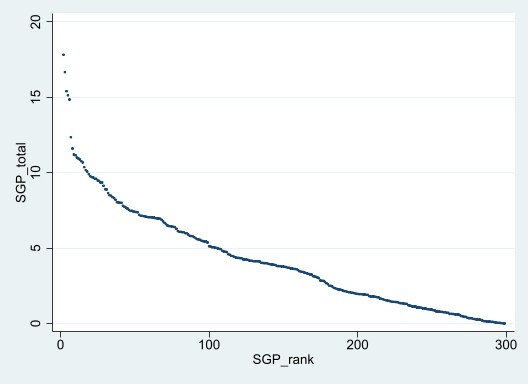Preface
It’s been a while since I’ve done one of these deep dives in Ottoneu basketball category leagues and I needed a break from prepping for my football draft. So here’s a post that explores SGP for that format that might be useful to someone out there.
Introduction
Specifically, this might be of interest to others who calculate their own auction values for category leagues or who are otherwise curious about the under-the-hood of scoring. Basically, I was curious what Standing Gain Points (SGP) looked like for Ottoneu basketball leagues last year for purposes of assigning values to players once projections are available.
Note that the empirical strategy was designed for season-long point leagues, not H2H. However, the correlations between the dollar values derived from the SGPs in the two formats is strong enough that I’d feel comfortable basing H2H values on them (or at least that’s my experience in H2H baseball leagues). For example, if Giannis is worth $120 in a hypothetical season-long category league, then he’ll be worth about $120 in a H2H as well.
Data
Recall that there are 8 category leagues; however, I excluded one league because so many teams had low MP totals, which suggests that a majority of the league was not engaged throughout the season. This isn’t a dig at members of the league; I just want to be transparent regarding the data that was used and it didn’t make sense to comingle data from leagues where the inactivity was evidently quite high.
Counting Stats
For counting stats, I assembled season-long totals for each league and then took the simple average across the 7 leagues. If you’re familiar with SGP, then you know that the calculations are much more straightforward with counting stats than percentage stats (see a few paragraphs down).
I calculated the SGP factors for the counting stats by running a bivariate regression of the counting stat on the rank in descending order. For example, if the highest number of points was 11,500, then that data point would be (12, 11,500). The resulting slope is then the SGP factor. Here are those SGP factors:
- PTS: 566.45
- REB: 222.71
- AST: 142.64
- STL: 31.54
- BLK: 30.56
- FTM: 119.14
- TOV: -66.81
The interpretation of an SGP factor is that on average it’s the number of the stat needed to advance one place in the standings. For example, on average 566.45 points would move you one point in the standings. To keep with the Giannis example, SGP_pts=2002/566.45=3.53 SGP.
Note that this has yet to be adjusted for replacement-level. Calculating replacement-level is a whole other post. For right now, I’ll stick to just presenting the SGP factors.
Percentage Stats
How would you calculate a SGP based on Giannis’ 55.3% FG%? There are two key data points from each player that are needed to calculate his SGP: his FGM and his FGA. This of course is analagous in baseball to needing to know his H and AB to figure out his marginal effect of a player on his team’s average.
You also need to know the league averages. So the first step is to figure out the FG% and FGA (less one full-time player) of the typical team in the typical league. I came up with 47.2% in 7,500 FGA (rounded to a nice even number), which implies 3,540 FGM per team across all league (less on full-time player).
The second step is to calculate the SGP factors as before: a bivariate regression to yield the slope. We need additional league data, so I’ll hold off on presenting those for the moment.
So there are four relevant data points for each percentage category: the SGP factor, league average FG%, league average team FGM, and league average team FGA.
So the following formula incorporates the two data points from each player (FGM, FGA) and three data points from the league averages. The formula for SGP_fg% is:
SGP_fg%=((Player_fgm+League_fgm)/(Player_fga+League_fga)-League_fg%)/SGP_fg%
So for Giannis (689 FGM, 1245 FGA) and the aforementioned league statistics (0.0040 SGP_fg%, 47.2% FG%, 3,540 FGM, 7,500 FGA), you get
SGP_fg%=((689+3540)/(1245+7500)-0.472)/0.0040=2.88
So this can be interpreted that Giannis’ 55.3% FG% improved his fantasy teams’ points from the FG% by 2.88 places in the standing (i.e., 2.88 SGP).
The SGP factors for the percentage statistics are:
- FG%: 0.0040 (assuming league average of 3,540 FGM, 7,500 FGA, and 47.2% FG%)
- 3P%: 0.0032 (assuming league average of 888 3PM, 2,500 3PA, and 35.5% 3P%)
Next Steps
Rotowire hasn’t published their 2022-23 projections, but I’m working with the 2021-22 actual game data via NatStat to try to come up with post hoc values for last season. Happy to post those if they’d be of interest to anyone. I won’t be able to share the values based on Rotowire projections since they’re paywalled, but I can share the post hoc 2021-22 values if those would be of interest.
